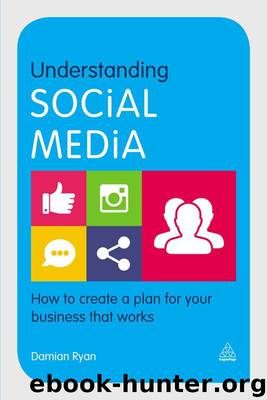Understanding Social Media: How to Create a Plan for Your Business that Works by Ryan Damian

Author:Ryan, Damian [Ryan, Damian]
Language: eng
Format: azw3, mobi, epub
Publisher: Kogan Page
Published: 2015-04-02T16:00:00+00:00
Ellie Mirman, director of marketing, HubSpot
Thirty terrible pieces of social media advice to ignore
1. You need to be on every single social network
Especially if you have limited time and resources, do not spread yourself too thin by trying to maintain an active presence on every single social media site. Research and learn about the make-up of the audience that populates each social network so you can figure out where you should focus. If your audience is not there, don’t waste your time. And as new social networks pop up (as they do all the time), feel free to experiment with them, but be ready to let them go if they don’t work for you, and let your analytics be your guide. At HubSpot, we have tried pretty much every social network that has popped up, but some have fallen by the wayside, and we have focused our efforts on the networks that continue to generate results for our marketing. Not sure where to start? LinkedIn, Facebook and Twitter are safe bets. They have huge audiences that span many demographics and industries.
2. Focus on Facebook…
Or LinkedIn… or Twitter… or social network XYZ. Yes, you should want to focus your social media marketing efforts but, at the same time, no single social media site is the Holy Grail. Experiment with a few sites, determine where your audience hangs out, and focus on the few that are the best fit for your company.
3. You don’t need e-mail
The day that Oprah Winfrey signed up for Twitter and user registration skyrocketed, we didn’t all cancel our e-mail accounts. I have been using Twitter for five years, Facebook and LinkedIn for even longer, and I live in my e-mail. Social media did not make e-mail marketing extinct: it just added another integrated channel to make e-mail even stronger. Remember: one of the first steps in signing up for a social media account is usually to provide your e-mail address. And communicating via social media, in some cases, is the same as communicating via e-mail. For example, a LinkedIn group message gets e-mailed to the group members via LinkedIn. On top of that, many people still prefer e-mail for communications, or prefer different types of content via e-mail rather than social posts.
4. Social media is the new search engine optimization (SEO)
If we’re talking buzz words, then yes, social media is the new SEO. But social media, in terms of function and strategy, does not replace SEO. In fact, it is just another case of two marketing strategies working better when they are put together. Social media posts now show in search results, social media engagement influences search rankings, and SEO can drive more people to your social profiles and posts. Once again, social media is an additional channel, not one that replaces existing efforts such as SEO. Billions of searches are conducted every single day, and you don’t want to miss out on that traffic.
5. You can automate all of your updates
Social media can be time-consuming, so the automation of your updates is, of course, appealing.
Download
Understanding Social Media: How to Create a Plan for Your Business that Works by Ryan Damian.mobi
Understanding Social Media: How to Create a Plan for Your Business that Works by Ryan Damian.epub
This site does not store any files on its server. We only index and link to content provided by other sites. Please contact the content providers to delete copyright contents if any and email us, we'll remove relevant links or contents immediately.
| Advertising | Consumer Behavior |
| Customer Service | Marketing |
| Public Relations | Sales & Selling |
| Search Engine Optimization |
Influence: The Psychology of Persuasion by Robert B. Cialdini(4714)
The Miracle Morning by Hal Elrod(4635)
The Hacking of the American Mind by Robert H. Lustig(4318)
Pre-Suasion: A Revolutionary Way to Influence and Persuade by Robert Cialdini(4142)
Unlabel: Selling You Without Selling Out by Marc Ecko(3587)
Ogilvy on Advertising by David Ogilvy(3503)
Hidden Persuasion: 33 psychological influence techniques in advertising by Marc Andrews & Matthijs van Leeuwen & Rick van Baaren(3472)
Purple Cow by Seth Godin(3137)
Who Can You Trust? by Rachel Botsman(3085)
Kick Ass in College: Highest Rated "How to Study in College" Book | 77 Ninja Study Skills Tips and Career Strategies | Motivational for College Students: A Guerrilla Guide to College Success by Fox Gunnar(3070)
The Marketing Plan Handbook: Develop Big-Picture Marketing Plans for Pennies on the Dollar by Robert W. Bly(2975)
This Is Marketing by Seth Godin(2969)
I Live in the Future & Here's How It Works by Nick Bilton(2933)
The Power of Broke by Daymond John(2893)
Building a StoryBrand by Donald Miller(2838)
The Tipping Point by Malcolm Gladwell(2819)
The 46 Rules of Genius: An Innovator's Guide to Creativity (Voices That Matter) by Marty Neumeier(2796)
Draw to Win: A Crash Course on How to Lead, Sell, and Innovate With Your Visual Mind by Dan Roam(2731)
Market Wizards by Jack D. Schwager(2643)
